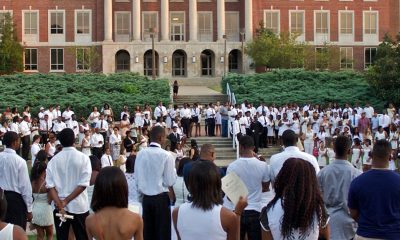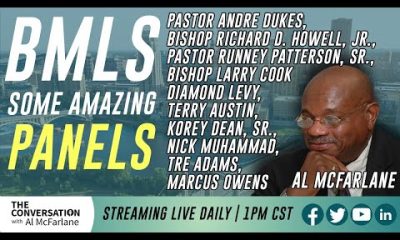Black History
Library of Congress Acquires Archive of Jazz Great Billy Strayhorn
CHARLESTON CHRONICLE — The Library of Congress announced in November that it has acquired the original manuscripts documenting the work of composer, arranger and pianist Billy Strayhorn.
By The Charleston Chronicle
The Library of Congress announced in November that it has acquired the original manuscripts documenting the work of composer, arranger and pianist Billy Strayhorn. An important star in the jazz firmament, Strayhorn was the source of much of the sound of the Duke Ellington Orchestra. He worked with Ellington for nearly 30 years, writing or collaborating on more than 200 tunes and arrangements for the band. Strayhorn wrote the orchestra’s signature tune, “Take the ‘A’ Train.”
The Strayhorn Collection contains nearly 18,000 documents, which include music manuscripts, lyric sheets and scripts, financial and business papers dating from the 1940s, and photographs from the 1930s through the 1960s. The richest portion of the collection is approximately 3,000 music manuscripts in Strayhorn’s own handwriting, including lead sheets, piano-vocal scores and complete orchestrations. These include compositions written solely by Strayhorn or in collaboration with Duke Ellington. The collection also has a wealth of sketch materials that were apparently unused or have remained unidentified.
Collection highlights include:
- Original manuscripts for hundreds of songs, including “Take the ‘A’ Train,” “Lush Life,” “Something to Live For,” “Chelsea Bridge,” “Rain Check” and “King Fit De Battle of Alabam”;
- Original manuscripts for musicals “Beggar’s Holiday” and “Rose Colored Glasses”;
- Contracts and other documents concerning Strayhorn’s business dealings with The American Society of Composers, Authors, and Publishers;
- Contracts for individual works including “Absinthe,” “Blossom,” “Christmas Present,” “Love Came,” “Passion Flower,” “Rosebud,” “Tigress” and “Watch Your Cue”;
- Autographed letter to Strayhorn from longtime partner Aaron Bridgers (1954);
- Autographed letter to Strayhorn from Luther Henderson (1966);
- Autographed essay, “Harmony,” examining Strayhorn’s approach to music writing, especially jazz, and compositional technique (undated);
- Two of Strayhorn’s personal address books and passports.
Although classically trained, Billy Strayhorn is better known for his work in jazz. “His contribution to American music since the 1940s has been enormous,” said Larry Appelbaum, the Library of Congress Music Division’s jazz specialist. “The Billy Strayhorn Collection documents the creative work of a musical architect of the highest order who spent most of his adult years working behind the scenes in the shadow and employ of Duke Ellington. Unlike many other musical geniuses, Strayhorn did not seek the limelight or attention, but scholars, performers, composers and arrangers — for the first time in 50 years — will finally have full public access to someone who added greatly to the brilliance and beauty of 20th-century music.”
Born on Nov. 29, 1915, in Dayton, Ohio, Strayhorn spent most of his formative years in and around Pittsburgh, where his family moved when he was about five years old, and in Hillsborough, North Carolina, the home of his mother’s family. He began taking piano lessons at an early age, followed by harmony instruction. He was composing in his teens and produced the musical “Fantastic Rhythm” in 1935 at the age of 19. Strayhorn continued to develop his skills as a composer and pianist, aspiring toward a career in classical music. He completed his first classic, “Lush Life” in 1936 when he was 20.
Strayhorn was 25 when he met bandleader and composer Duke Ellington in 1938. A month later, he began his 28-year association with Ellington. The multi-talented Strayhorn wrote or collaborated on some of the band’s biggest hits and also arranged a substantial part of the Ellington Orchestra’s repertoire. He also occasionally served as lyricist, vocal coach and second pianist in the orchestra. He died at the age of 51 on May 31, 1967.
Since Strayhorn’s death, his original manuscripts have been in the custody of the Strayhorn family and have been available only for limited scholarship. The acquisition of the Billy Strayhorn Music Manuscripts and Estate Papers will enhance the Library’s existing materials documenting Strayhorn’s legacy. Foremost among these are the original manuscript scores for his first musical, “Fantastic Rhythm” and the 1941 musical co-written by Strayhorn and Ellington, “Jump for Joy.”
In addition, the Library has in its collections 50 songs composed by Strayhorn that were registered for copyright during the period of 1941-1969 and 51 compositions by Strayhorn and Ellington that were submitted for copyright from 1939 -1965. All of these materials will be available in the Music Division’s Performing Arts Reading Room on Capitol Hill in Washington, D.C. The Strayhorn collection will enrich the existing collections of Max Roach, Charles Mingus, Billy Taylor, Gerry Mulligan, Alvin Ailey, Dexter Gordon and Shelly Manne.
A finding aid for the Strayhorn collection can be found at
http://findingaids.loc.gov/exist_collections/service/music/eadxmlmusic/eadpdfmusic/2018/mu018014.pdf.
This article originally appeared in the Charleston Chronicle.
Activism
Oakland Post: Week of April 24 – 30, 2024
The printed Weekly Edition of the Oakland Post: Week of April 24 – 30, 2024

To enlarge your view of this issue, use the slider, magnifying glass icon or full page icon in the lower right corner of the browser window. ![]()
Activism
Oakland Post: Week of April 17 – 23, 2024
The printed Weekly Edition of the Oakland Post: Week of April 17 – 23, 2024

To enlarge your view of this issue, use the slider, magnifying glass icon or full page icon in the lower right corner of the browser window. ![]()
Black History
Matthew Henson: Explorer Extraordinaire
Matthew Henson, a trailblazing explorer who overcame countless obstacles to leave an incredible mark on history. Born on August 8, 1866, in Charles County, Maryland, his journey is a testament to the power of determination and the spirit of adventure.

By Tamara Shiloh
Matthew Henson, a trailblazing explorer who overcame countless obstacles to leave an incredible mark on history. Born on August 8, 1866, in Charles County, Maryland, his journey is a testament to the power of determination and the spirit of adventure.
Henson’s life began amidst the backdrop of post-Civil War America, where opportunities for African Americans were scarce. From a young age, he possessed an insatiable curiosity about the world beyond his small town. At the age of 12, he embarked on a journey that would change the course of his life forever when he joined a merchant ship as a cabin boy.
His most famous expedition was his journey to the Arctic with renowned explorer Robert E. Peary. In 1887, Henson joined Peary’s crew as a seaman and quickly proved himself to be invaluable with his skills as a navigator and craftsman. Over the course of several expeditions, Matthew endured extreme cold, treacherous terrain, and grueling conditions as he and Peary sought to reach the elusive North Pole.
In 1908–09, Peary set out on his eighth attempt to reach the North Pole. It was a big expedition, with Peary planning to leave supplies along the way. When he and Henson boarded their ship, the Roosevelt, leaving Greenland on August 18, 1909, they were joined by a large group. This included 22 Inuit men, 17 Inuit women, 10 children, 246 dogs, 70 tons of whale meat, blubber from 50 walruses, hunting gear, and tons of coal.
In February, Henson and Peary left their anchored ship at Ellesmere Island’s Cape Sheridan, along with the Inuit men and 130 dogs. They worked together to set up a trail and supplies along the way to the Pole.
Peary picked Henson and four Inuit people to join him in the final push to the Pole. However, before they reached their destination, Peary couldn’t walk anymore and had to ride in a dog sled. He sent Henson ahead to scout the way. In a later interview with a newspaper, Henson recalled being in the lead and realizing they had gone too far. The group turned back, and Henson noticed his footprints helped guide them to their destination. At that location, Henson planted the American flag.
Henson’s legacy extends far beyond his expeditions to the Arctic. He shattered racial barriers in the world of exploration and inspired countless individuals, regardless of race, to dream big and pursue their passions. In 1937, he was finally recognized for his achievements when he was inducted into The Explorers Club, an organization dedicated to promoting scientific exploration and field research.
Matthew Henson died in the Bronx, New York, on March 9, 1955, at the age of 88.
-

 Community2 weeks ago
Community2 weeks agoFinancial Assistance Bill for Descendants of Enslaved Persons to Help Them Purchase, Own, or Maintain a Home
-

 Activism3 weeks ago
Activism3 weeks agoOakland Post: Week of April 3 – 6, 2024
-

 Business2 weeks ago
Business2 weeks agoV.P. Kamala Harris: Americans With Criminal Records Will Soon Be Eligible for SBA Loans
-

 Community2 weeks ago
Community2 weeks agoAG Bonta Says Oakland School Leaders Should Comply with State Laws to Avoid ‘Disparate Harm’ When Closing or Merging Schools
-

 Activism2 weeks ago
Activism2 weeks agoOakland Post: Week of April 10 – 16, 2024
-

 Community1 week ago
Community1 week agoOakland WNBA Player to be Inducted Into Hall of Fame
-

 Community1 week ago
Community1 week agoRichmond Nonprofit Helps Ex-Felons Get Back on Their Feet
-

 Community2 weeks ago
Community2 weeks agoThe Year Ahead: Assembly Speaker Rivas Discusses Priorities, Problems

























































